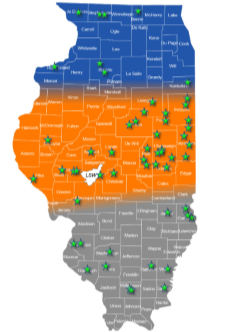In 2017, NREC funded 49 N Rate Trials, the highest number of N rate trials in Illinois to date. This project also expanded into Southern Illinois; 12 of the trials were implemented in this underserved region and we also implemented trials in Western Illinois. IFCA identified the participating farmers and implemented the trials, and the UI evaluated the yield results at 0, 50, 100, 150, 200 and 250 pound N rates in the field.

The trials also include a Rate by Timing protocol to look at fall vs spring applications and at split nitrogen applications. In 2017, there were enough N rate trials funded by NREC in the Lake Springfield watershed for UI to establish a MRTN specific to this watershed. IFCA and UI worked with Iowa State University to update the Illinois MRTN website in 2017, and it now includes the new Lake Springfield MRTN, and all the N rate trial data produced with support from NREC over the past several years. The 2017 N rate trials are indicated with the green stars. The Illinois MRTN is part of the Nitrogen Rate Calculator System and is available at http://cnrc.agron.iastate.edu.
Summary slides of the 2017 N rate trials, (as well as trials performed in 2014, 2015 and 2016) are available at the IFCA website, showing each trial’s optimum return to nitrogen compared to the MRTN: https://ifca.com/4R/Trials/ The IFCA website also provides a summary of the 2017 trials by year, and by region of the state (north, central and south).

The bottom line? Many farmers achieved optimum “return to nitrogen” at rates lower than the MRTN, some produced optimum yields squarely in line with the MRTN, and a few growers still needed more nitrogen to optimize yields. However, over the last several years of research, the MRTN has clearly established a “optimum” nitrogen rate that when utilized, provides the best possible recommendation that assures yield while not encouraging over application of nitrogen, which can be lost to the environment. The INLRS lists using the MRTN as a key activity in reducing nitrogen losses, especially in tile drained fields. This research helps build industry confidence in the MRTN and ensures that Illinois nitrogen rate recommendations are fueled by current on-farm research.